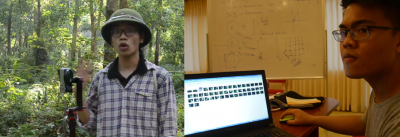Creation of virtual forest tours
The creation of virtual forest tours implicates several intermediate steps until a forest stand becomes accessible via computer. This process – from the choice of proper photography equipment to the publication of the generated virtual tour – is displayed in the following guide. It emerged from the ‘Flipped Classroom’ project by Prof. Dr. Spathelf of the Eberswalde University for Sustainable Development which aims to investigate new learning and teaching methods in international forestry.
View the guide to get started with your own virtual forest tour: Flipped Classroom Guide
Furthermore, some empirical knowledge about the generation of virtual forest tours under tropical conditions can be found in the following additional document: Recommendations and improvements for 360° tours
Video: Production process of virtual forest tours
Prof. Dr. José A. Reque Kilchenmann benefitted from great engagement of VNU students. Next to Doan Manh Linh and Nguyen Thi Van, Nguyen Hoang Nam and Pham Minh Anh took the photographs while Ngo Xuan Phong stitched the images.
The team documented the production process for the virtual tour. Take a look and see how it works:
Marteloscopes & Decision Support Systems (DSS)
In the BioEcoN project, virtual forest tours were created to allow the virtual exploration of the projects’ marteloscopes – permanent forest plots established during the project for research and education purposes. Visit our dedicated marteloscopes page to learn more about what defines a marteloscope, and for tutorials describing methods for plot demarcation, stand-mapping and collection of biological, geological and climatic characteristics related to the stand.
More information is available from the Integrate+ Project led by the European Forest Institute, which established a network of marteloscope sites throughout the EU. For example, “What is a Marteloscope?” and “Description of parameters and assessment procedures“.
In addition to virtual forest tours created to explore the marteloscopes remotely online, Decision Support Systems (DSS) software can be used to evaluate the ecological qualities of the forest stand or simulate natural development or responses to various management actions, based on the tree and site data collected in the marteloscopes. In this regard, marteloscopes provide a medium for education and practical training both in the field and behind the computer – or both using portable devices in the field (read more on the software page)
Through the BioEcoN project, a DSS named Smartelo was developed specially for application with tree and site data acquired from the project marteloscopes. This includes the parameterization of tree biometric data and growth models specific to those found in the temperate, temperate-Mediterranean and tropical forests represented in the project. Free learning materials from the BioEcoN curriculum include theoretical explanation and practical training on the use of the Smartelo DSS. Tutuorials were also produced for use of Smartelo on both PC and portable devices.
SERVIR GLOBAL
A joint development initiative of National Aeronautics and Space Administration (NASA) and United States Agency for International Development (USAID), SERVIR works in partnership with leading regional organizations world-wide to help developing countries use information provided by Earth observing satellites and geospatial technologies for managing climate risks and land use. We empower decision-makers with tools, products, and services to act locally on climate-sensitive issues such as disasters, agriculture, water, and ecosystems and land use.
SERVIR is improving awareness, increasing access to information, and supporting analysis to help people in West Africa, Eastern and Southern Africa, Hindu Kush-Himalaya, the Lower Mekong, South America and Mesoamerica manage challenges in the areas of food security, water resources, land use change, and natural disasters. With activities in more than 45 countries and counting, SERVIR has already developed over 70 custom tools, collaborated with over 250 institutions, and trained more than 3000 individuals, improving the capacity to develop local solutions.
The followed links provide the news and download option about a new handbook from SERVIR: Release of Synthetic Aperture Radar (SAR) Handbook to empower the monitoring and protection of forests worldwide
SAR Hamdbook: Comprehensive Methodologies for Forest Monitoring and Biomass Estimation


